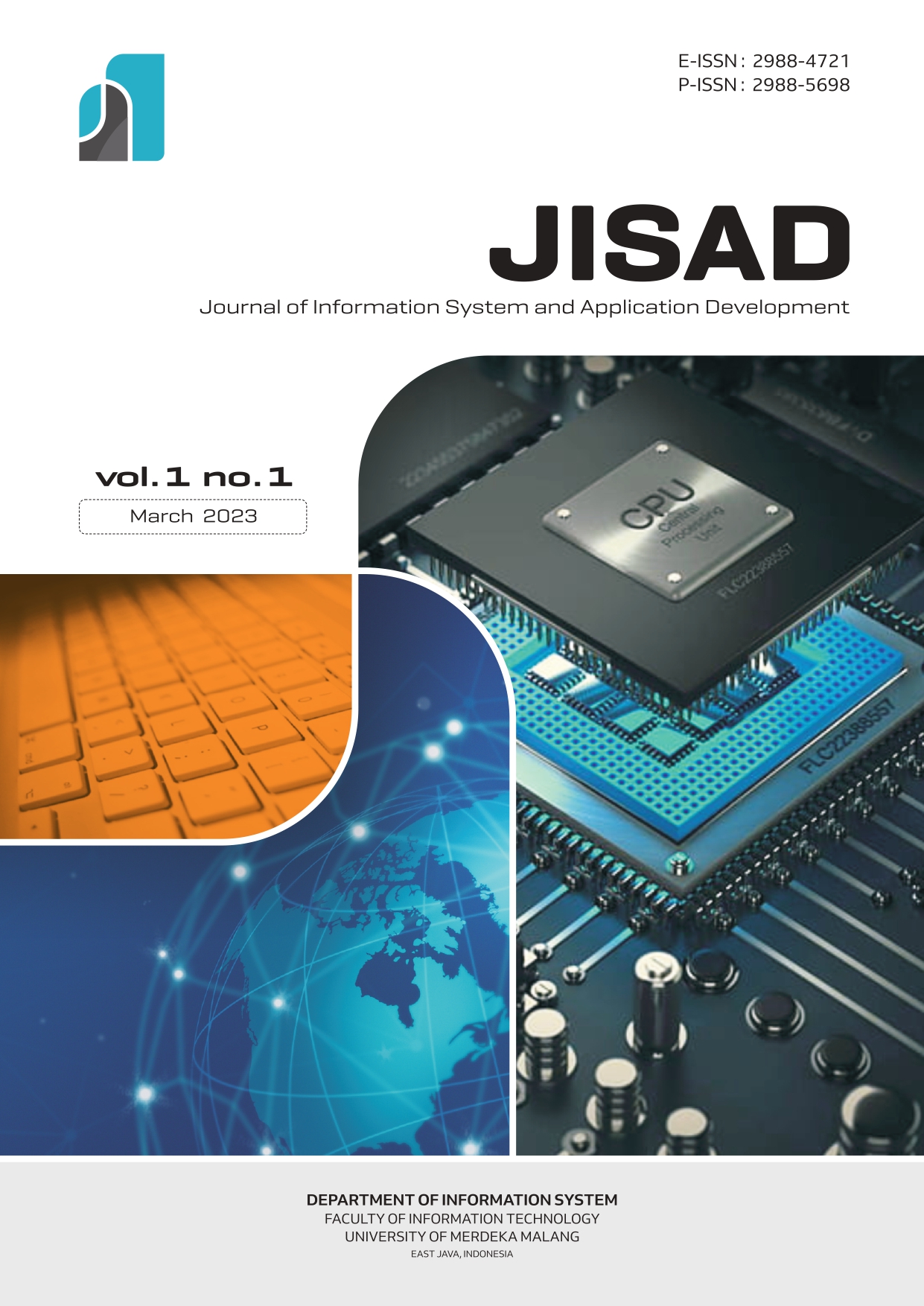Pengembangan aplikasi kesehatan ibu dan balita berbasis web untuk Puskesmas
DOI:
https://doi.org/10.26905/jisad.v1i1.9859Keywords:
Public Health Center, child growth, digitalization, waterfall modelAbstract
Puskesmas manages the Posyandu which acts as a forum for monitoring the growth of toddlers and the health of mothers. Posyandu holds routine activities ranging from weighing, immunization, to consultations, where the data obtained is recorded in the “Kartu Menuju Sehat” book. The process of recording data that is still done manually can risk causing problems such as errors in data collection. This study aims to update the data management system for Posyandu by digitizing it using the Waterfall method approach. The web-based application was developed in order to assist Posyandu cadres in the data management process while at the same time facilitating Puskesmas staff in efforts to control malnutrition. In addition, this application can be an alternative to filling out the “Kartu Menuju Sehat” book, thereby facilitating the child growth recapitulation process. The child's growth report will be recorded in the system after the toddler carries out an examination at the Posyandu and the cadre fills in the toddler's examination data. Cadres can then arrange the Posyandu implementation schedule and immunization list for the next period. Through the application developed, Posyandu cadres can collect data on mothers and toddlers and can manage data more easily and quickly.
Downloads
References
[1] E. S. Sulaeman, Teori dan Praktik di Puskesmas. D.I. Yogyakarta: Gadjah Mada University Press, 2021.
[2] A. Nuriyanto, Aplikasi Keperawatan Profesional Di Puskesmas. Surakarta: CV Kekata Group, 2020.
[3] S. Fatimah and F. Indrawati, “Faktor Pemanfaatan Pelayanan Kesehatan di Puskesmas,” Higeia J. Public Heal. Res. Dev., vol. 1, no. 3, pp. 84–94, 2019.
[4] A. H. Al Rahmad, “Modul pendamping KMS sebagai sarana ibu untuk memantau pertumbuhan balita,” vol. 3, no. 1, pp. 48–56, 2018, doi: 10.30867/action.v3i1.9.
[5] T. Thesing, C. Feldmann, and M. Burchardt, “Agile versus Waterfall Project Management: Decision model for selecting the appropriate approach to a project,” Procedia Comput. Sci., vol. 181, pp. 746–756, 2021, doi: 10.1016/j.procs.2021.01.227.
[6] A. Rifai and Y. P. Yuniar, “Penerapan Metode Waterfall Dalam Perancangan Sistem Informasi Ujian Pada SMK Indonesia Global Berbasis Web,” J. Khatulistiwa Inform., vol. 7, no. 1, pp. 1–6, 2019, doi: 10.31294/jki.v7i1.64.
[7] M. Tabrani, “Penerapan Metode Waterfall Pada Sistem Informasi Inventori Pt. Pangan Sehat Sejahtera,” J. Inkofar, vol. 1, no. 2, pp. 30–40, 2018, doi: 10.46846/jurnalinkofar.v1i2.12.
[8] R. R. J. Jardim, M. Santos, E. Neto, E. da Silva, and F. de Barros, “Integration of the waterfall model with ISO/IEC/IEEE 29148:2018 for the development of military defense system,” IEEE Lat. Am. Trans., vol. 18, no. 12, pp. 2096–2103, 2020, doi: 10.1109/TLA.2020.9400437.
[9] D. S. Purnia, A. Rifai, and S. Rahmatullah, “Penerapan Metode Waterfall dalam Perancangan Sistem Informasi Aplikasi Bantuan Sosial Berbasis Android,” Semin. Nas. Sains dan Teknol. 2019, pp. 1–7, 2019.
[10] I. Dan, T. Intech, K. Afi, Z. F. Azzahra, and A. D. Anggoro, “Analisis Teknik Entity - Relationship Diagram dalam Perancangan Database : Sebuah Literature Review,” vol. 3, no. 1, pp. 8–11, 2022.
[11] N. Kharmoum, W. Rhalem, S. Retal, K. El bouchti, and S. Ziti, “Getting the UML’s Behavior and Interaction Diagrams by Extracting Business Rules Through the Data Flow Diagram,” in Advanced Intelligent Systems for Sustainable Development (AI2SD’2020), 2022, pp. 540–547.
[12] Y. Wu and P. Xie, “Exploration of Enterprise Audit Information Management System Model Based on Data Flow Diagram,” in 2021 International Wireless Communications and Mobile Computing (IWCMC), 2021, pp. 1997–2001. doi: 10.1109/IWCMC51323.2021.9498870.
[13] W. N. Cholifah, Y. Yulianingsih, and S. M. Sagita, “Pengujian Black Box Testing pada Aplikasi Action & Strategy Berbasis Android dengan Teknologi Phonegap,” STRING (Satuan Tulisan Ris. dan Inov. Teknol., vol. 3, no. 2, p. 206, 2018, doi: 10.30998/string.v3i2.3048.
[14] Z. Chen et al., “Exploring Better Black-Box Test Case Prioritization via Log Analysis,” ACM Trans. Softw. Eng. Methodol., Oct. 2022, doi: 10.1145/3569932.
[15] D. Debiyanti, S. Sutrisna, B. Budrio, A. K. Kamal, and Y. Yulianti, “Pengujian Black Box pada Perangkat Lunak Sistem Penilaian Mahasiswa Menggunakan Teknik Boundary Value Analysis,” J. Inform. Univ. Pamulang, vol. 5, no. 2, p. 162, 2020, doi: 10.32493/informatika.v5i2.5446.
Downloads
Additional Files
Published
Issue
Section
License
Copyright (c) 2023 Journal of Information System and Application Development

This work is licensed under a Creative Commons Attribution-ShareAlike 4.0 International License.
Authors who publish in this journal agree to the following terms:
(1) Copyright of the published articles will be transferred to the journal as the publisher of the manuscripts. Therefore, the author confirms that the journal has managed the copyright.
(2) Publisher of JISAD: Journal of Information System and Application Development is the University of Merdeka Malang.
(3) The copyright follows Creative Commons Attribution ShareAlike License (CC BY SA): This license allows to Share - copy and redistribute the material in any medium or format, Adapt - remix, transform, and build upon the material, for any purpose, even commercially.






